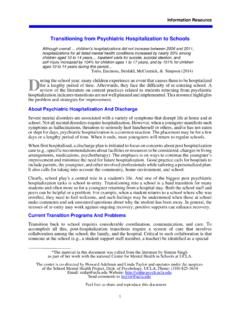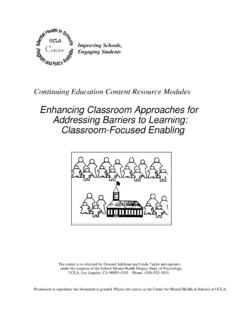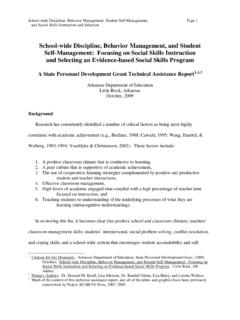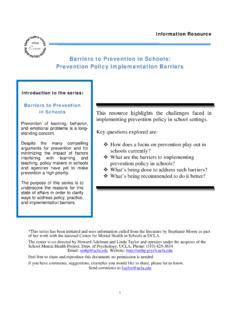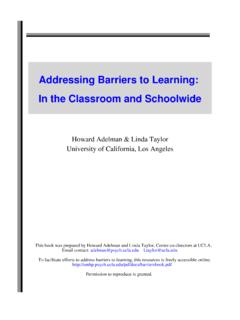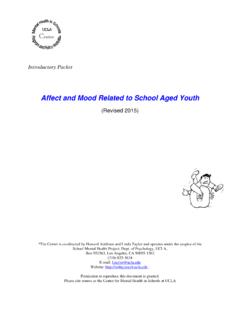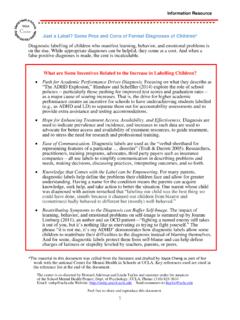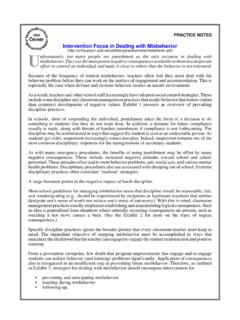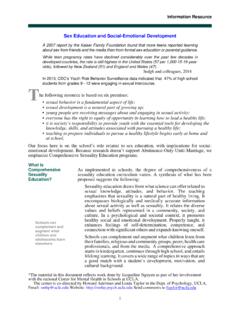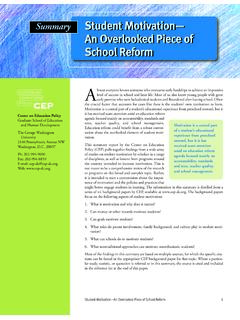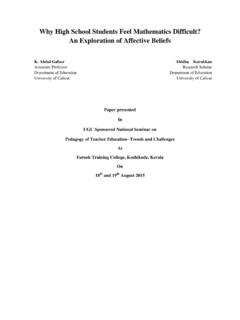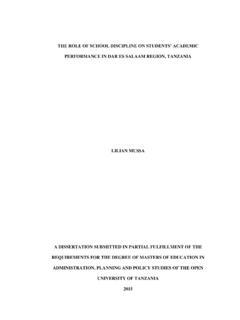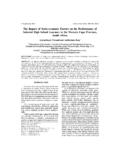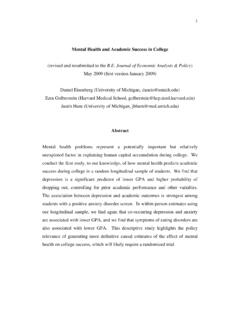Transcription of School Attendance Problems: Are Current Policies & Practices …
1 A Center Policy & Practice Analysis Brief .. School Attendance Problems: Are Current Policies & Practices Going in the Right Direction? This Center is co-directed by Howard Adelman and Linda Taylor and operates under the auspices of the School Mental Health Project, Dept. of Psychology, UCLA. Center for Mental Health in Schools, Box 951563, Los Angeles, CA 90095-1563(310) 825-3634 Fax: (310) 206-5895; E-mail: Website: Permission to reproduce this document is granted. Please cite source as the Center for Mental Health in Schools at UCLA. Please reference this document as follows: Center for Mental Health in Schools at UCLA. (2008 update). School Attendance Problems: Are Current Policies & Practices Going in the Right Direction? Los Angeles, CA: AuthorCopies may be downloaded from: needed, copies may be ordered from:Center for Mental Health in SchoolsUCLA Dept. of Box 951563 Los Angeles, CA 90095-1563 The Center encourages widespread sharing of all student absence jeopardizes the ability of students to succeedat School and schools to achieve their mission.
2 students who arenot at School cannot receive instruction. Schools funded on thebasis of average daily Attendance have less resources to do the youngsters who are truant from School engage in behaviorsthat are illegal. And the correlates of School Attendance problemsgo on and School absences is one of the most challenging mattersfacing schools. In addressing the problem, it is important to beginby exploring two questions: What factors lead to student absences? How can schools more effectively address the problem?This brief provides a quick overview of issues related to schoolattendance problems and then frames directions for policy andpractice. As with all Center briefs, it is meant to highlight the topicand provide a tool for discussion by School policy makers the Problem 1 What are the Numbers? 2 Why Don t They Come to School ? 2 Transition Times and Attendance Problems 4 Disengagement From School 4 When Does Lack of Regular Attendance Become Truancy?
3 5 Examples of Current Policies and Practices Related to Attendance Problems 6 Disincentives and Incentives 6 Supporting Student Attendance 7 Schools and Community Working Together 7 Toward Better Policies and Practices :The Key is Helping students Feel Connected 9 Transition Interventions 9 Connecting with students Who Are Becoming Disengaged 11 Conclusions13 Resources and References14 Appendices:17A. Examples of State and District Policies Related to AttendanceB. A Sampling of Truancy ProgramsC. A Sampling of Transition Support ProgramsD. About School Engagement Research1 School Attendance Problems: Are Current Policies & Practices Going in the Right Direction? students cannot perform well academically when they are frequentlyabsent. An individual student s low Attendance is a symptom ofdisengagement and academic difficulties. But when many students havelow Attendance in classes, such behavior undermines the capacity of allstudents and teachers to pursue high quality education.
4 From: Habits Hard to Break: A New Look at Truancy in Chicago s Public High SchoolsAttendance Matters! New Research supports the unquestionable linkbetween Attendance and student achievement. students who attend schoolbetween 85 and 100 percent of the time pass the state tests in reading andmath at much higher rates than students who attend School less than 85percent of the Minneapolis Public Schools the ProblemHow important is Attendance to School success? Why do students skip School ? Whatdo schools do when students have Attendance problems? How effective are existingpolicies and Practices ? School Attendance is a constant concern in schools. Average daily Attendance rates are acommon determiner of School funding. Academic achievement scores are correlated withschool Attendance . Excessive School absence is a precursor of School dropout. Each School , district, and state have statements of policy regarding Attendance . They addresssuch questions as: What is an excused absence?
5 What should be done about unexcusedabsences? When are absences severe and chronic? When does the School team work with thelegal system to address truancy? What are the interventions and consequences for truancy?Prevailing Policies that simply mandate Attendance and spell out increasingly harshpunishments for unexcused absences fail to take into account the range of underlying causesof Attendance problems and the range of prevention, early intervention, and ongoing supportthat might more effectively address the problems. To highlight the topic and provide a tool for discussion by School policy makers andpractitioners, this brief first provides some background and overview of issues related toschool Attendance problems. This is followed by an emphasis on policy and practice that goesbeyond graduated sanctions. 2 What are the Numbers? High School students inDenver Public Schools aremissing an average of 25days per School year andfully a third meet the legaldefinition of chronicallytruant - meaning theycould wind up in data, released Friday,shows how big a challengeDPS faces in meeting theattendance goal set bySuperintendent MichaelBennet.
6 His goal is a 97percent Attendance rate inhigh schools, or no morethan six days missed perstudent during the year. Rocky Mountain News (4/29/06) Why Don t They Come to School ? Data from the Condition of Education 2000-2006 indicate thefollowing data for elementary and middle schools: In 2005, 19 percent of 4th-graders and 20 percent of8th-graders reported missing 3 or more days of schoolin the previous month.. In both grades, studentswere more likely to miss 3 or more days of School if alanguage other than English was spoken at home, ifthe student was an English language learner, or if thestudent was classified as having a , in both grades, a lower percentage ofAsian/Pacific Islander students and a higherpercentage of American Indian students reportedmissing 3 or more days of School than their peers inother racial and ethnic groups.
7 students who wereeligible for a free or reduced-price lunch were morelikely to be absent from School for 3 or more days thanthose who were not eligible. This pattern amongstudents eligible for a free or reduced-price lunch hasremained stable for both 4th- and 8th-grade studentsbetween 1998 and 2005. The National Center for Education Statistics indicates the followdata for 10th graders during the first half of the 2002-2003 of all students missed no missed 1-2 days missed 3-6 missed more than 6 days Routines for School Attendance are established for most students atan early age. Families demonstrate the importance of regular schoolattendance by establishing routines that support studentspreparedness for School (have supplies, homework done, lunchready, arranged transportation to arrive at School on time). Some student miss School because they are reacting to proactively choose not to come to School in order to seek outother activities.
8 In a few cases, the first days of School for beginning students mayinclude mild separation anxiety which is usually addressed by schoolstaff and families working together on programs to increaseyoungsters support networks at School . In a very few cases, students may demonstrate School avoidance, andsome students health problems may disrupt School some students , School Policies related to behavior lead toexclusion from School (suspensions and expulsions related tofighting, gang affiliation, drugs, or weapons}.3 For students over themandatory age forschool attendanceand are chronicallyabsent, many schooldistrict Policies areto drop the studentsfrom the schoolrolls. This improvesthe attendancerecord , but doesn tdo much for thedropout statistics. Data indicate that some students report missing School because theyare the victims of threats and bullying. Indicators of School Crimeand Safety: 2005 reports the following: In the School Crime Supplement to the National CrimeVictimization Survey, students ages 12 18 were askedwhether they had avoided School activities or one or moreplaces in the School because they were fearful.)
9 In 2003, 5percent of students reported that they avoided School activitiesor one or more places in School in the previous 6 monthsbecause they were fearful: 2 percent of students avoided schoolactivities (skipped extracurricular activities, skipped class, orstayed home from School ), and 4 percent of students avoidedone or more places in School (the entrance to the School , anyhallways or stairs in the School , any parts of the schoolcafeteria, any School restrooms, and other places inside theschool building). The U. S. Department of Education s online training document: Truancy: a serious problem forstudents, schools, and society puts the range of causes of School Attendance problems into aframework. That document categorizes Factors that Contribute to Truancy as follows:I. School Factors> School safety > School size >Attitudes of School staff and fellow students >Flexibility in meeting students ' diverse learning styles >Failure to successfully notify parents/guardians about each absence >Lack of consistency and uniformity to Attendance and Attendance policy withinschools and districts II.
10 Family Factors>Lack of parent supervision and/or guidance>Poverty >Substance abuse >Domestic violence >Lack of familiarity with School Attendance laws >Varied education priorities III. Economic Factors >Student employment >Single-parent households >Parents with multiple jobs >Families that lack affordable transportation and/or child care IV. Student Factors:>Substance use >Limited social and emotional competence >Mental health problems >Poor physical health >Lack of familiarity with School Attendance laws >Teen pregnancy >Truant friends 4 Transition Times & Attendance Problems DisengagementFrom SchoolPeriods of transition can increase School Attendance problems for allstudents and especially for some. students and their families areinvolved in important transitions every day and throughout the years ofschooling. Examples of such transition periods include:>Entry into School at kindergarten>Moving to a new home and entry into a new School >Beginning a new year in a new class>Articulation from elementary to middle or middle to high School >Re-entry from suspensions, expulsions, juvenile detention>Inclusion from special education to regular educationTransitional failure can lead to School absences.
